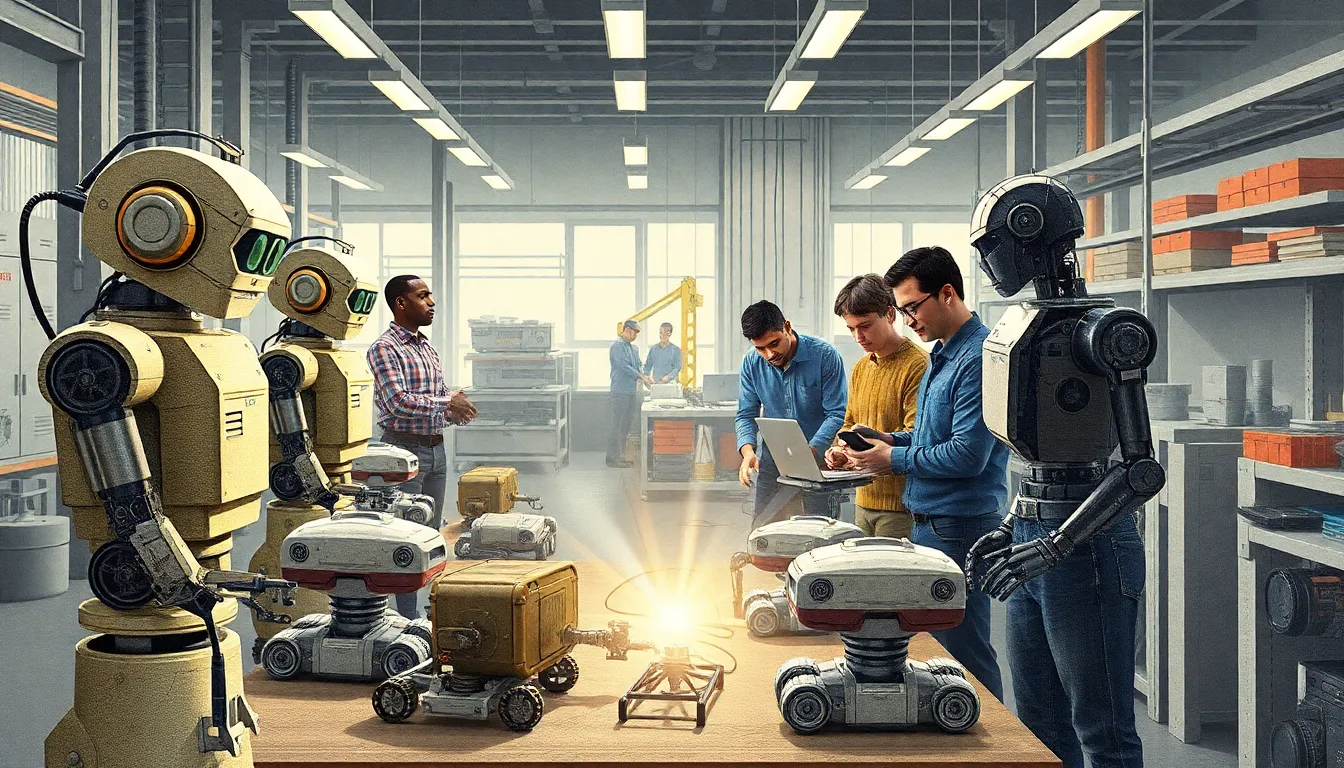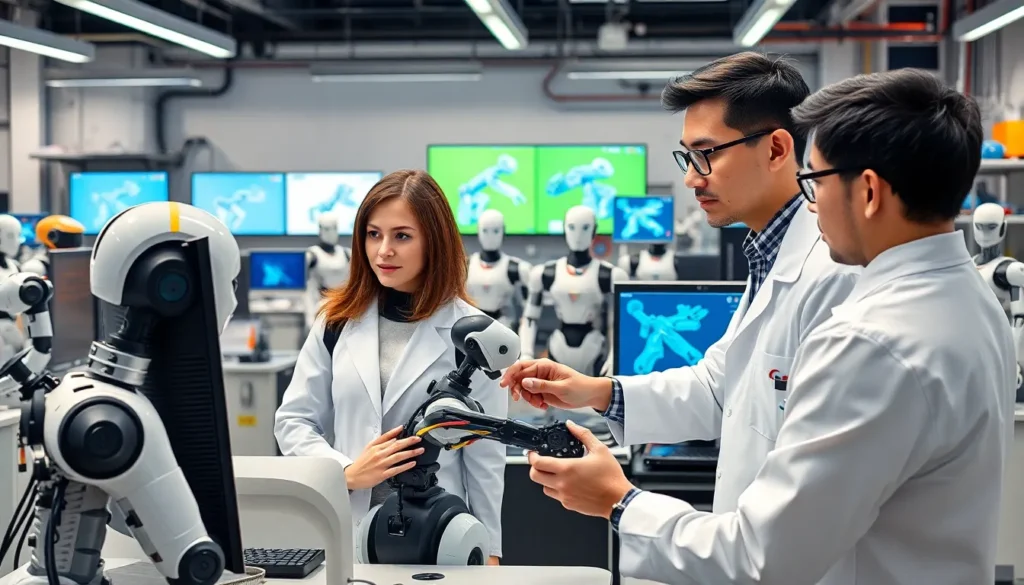In a world where robots are no longer just the stuff of sci-fi dreams, the development of these mechanical marvels is advancing at breakneck speed. From vacuuming the floor to flipping burgers, robots are becoming the multitasking sidekicks we never knew we needed. Imagine a future where your coffee is brewed by a friendly bot while it simultaneously reminds you of your upcoming Zoom call—talk about a personal assistant with flair!
But it’s not all smooth sailing in the land of robotics. As engineers tinker away in their labs, they face a host of challenges that would make even the most patient robot throw up its mechanical hands. Dive into the fascinating world of robot development, where innovation meets a dash of humor and a sprinkle of chaos, and discover how these creations are reshaping our lives one circuit at a time.
Table of Contents
ToggleOverview of Robot Development
Robot development covers various disciplines, including artificial intelligence, mechanical engineering, and electronics. Engineers focus on creating systems that can execute specific tasks with increasing efficiency. Advancements in sensors and software enable robots to adapt to their environments, enhancing their functionality.
Developers utilize machine learning to improve robot decision-making processes. This technology allows robots to learn from past experiences, making them more effective in real-world applications. Collaborative robots, or cobots, work alongside humans in fields like manufacturing, benefiting from enhanced safety and efficiency.
Programming languages, such as Python and C++, play essential roles in robot functionalities. These languages provide the necessary frameworks for building algorithms that manage robot behavior. Open-source platforms, like ROS (Robot Operating System), facilitate collaboration among developers, driving innovation in robotics.
Challenges in robot development frequently arise from complex environments and the need for reliable interaction with humans. Cognitive robotics aims to address these issues, focusing on enabling robots to understand and process human emotions and intentions. Developing robust safety measures remains crucial, ensuring robots can operate safely alongside people.
As robots continue to evolve, their applications expand across various sectors, including healthcare, logistics, and agriculture. Autonomous delivery drones exemplify this shift, demonstrating robots’ potential to streamline operations. The continuous integration of robotics into daily life creates new opportunities, redefining how humans and machines coexist.
Historical Background

Robot development has a rich history, marked by significant milestones that have shaped its current landscape. This evolution traces back to early innovations that laid the groundwork for modern robotics.
Early Innovations
The 20th century marked the dawn of robotic concepts with inventions like the Unimate, the first industrial robot, created in 1961. This robot revolutionized manufacturing tasks, particularly in automotive assembly lines. Meanwhile, researchers began exploring artificial intelligence, paving the way for smarter machines. The 1960s and 1970s saw significant contributions from pioneers like Shakey, a mobile robot that could navigate its environment. These breakthroughs laid the foundation for the field of robotics.
Modern Advancements
Today, advancements in robotics thrive on interdisciplinary collaboration. Engineers utilize AI and machine learning to enhance robot autonomy and decision-making capabilities. Collaborative robots, or cobots, actively assist human workers, transforming workplaces across industries. In healthcare, robots perform intricate surgeries with precision. Drones increasingly serve logistics by autonomously delivering packages. Open-source platforms foster innovation, allowing developers to create and refine robotic applications rapidly. Robust progress continues to shape robots into invaluable tools for everyday life.
Key Technologies in Robot Development
Robot development relies heavily on a combination of advanced technologies, enhancing capabilities and performance. Understanding these key technologies provides insight into the future of robotics.
Artificial Intelligence
Artificial intelligence equips robots with the ability to learn and adapt. Through machine learning algorithms, robots analyze data to make informed decisions. Natural language processing enables them to communicate effectively with humans. Vision systems allow robots to perceive their environments, identifying objects and obstacles in real-time. These features collectively enhance automation, making robots more efficient and responsive.
Robotics Engineering
Robotics engineering comprises mechanical design, control systems, and software integration. The mechanical design focuses on creating structures and components that allow mobility and functionality. Control systems implement algorithms that govern robot movements and actions. Software integration ensures seamless interactions between hardware and programming, facilitating advanced operations. Each of these elements must work in harmony to create robust and reliable robotic systems.
Applications of Robots
Robots play crucial roles across various sectors, transforming operations and enhancing productivity.
Industrial Automation
In industrial environments, robots streamline processes and improve efficiency. They perform tasks like assembly, welding, and painting, reducing human error. Collaborative robots, or cobots, assist workers by taking on repetitive or hazardous tasks. This collaboration enhances safety while increasing output. A 2021 study showed that factories using robots reported a 30% increase in productivity. The automotive industry, for instance, relies heavily on robots for precision and speed on assembly lines.
Healthcare Robotics
Healthcare robotics significantly enhance patient care and surgical procedures. Surgical robots enable surgeons to perform complex operations with high precision, minimizing invasiveness. Telepresence robots allow doctors to consult and diagnose patients remotely, improving access to care. As of 2022, over 10% of surgeries in the United States used robotic assistance. Rehabilitation robots assist patients in regaining movement and strength, illustrating advancements in robotic technologies that actively contribute to improved recovery times.
Service Robots
Service robots assist in everyday tasks, making life easier for individuals and businesses alike. They can be found in hospitality settings, providing customer support and delivering items. Cleaning robots autonomously navigate spaces, ensuring cleanliness without human intervention. By 2023, the service robot market projected growth to $30 billion, reflecting their rising demand. Home automation, powered by robots, offers convenience that enhances daily living, allowing users to manage tasks efficiently and enjoy greater leisure time.
Future Trends in Robot Development
Future trends in robot development are shaped by numerous factors, including technology innovations and ethical considerations. As robotics evolves, new capabilities and applications emerge, transforming various industries.
Emerging Technologies
Robots increasingly incorporate advanced technologies like artificial intelligence and machine learning. AI systems enable robots to adapt their behaviors based on real-time data, enhancing their functionality. Robotics engineers focus on creating more agile and autonomous machines, with robotics platforms supporting seamless updates. Technologies such as 5G networks contribute to faster data processing, allowing robots to operate efficiently in real-time environments. Furthermore, the integration of sensors enhances interaction with surroundings, improving navigational capabilities. Collaborative and autonomous systems gain traction, particularly in manufacturing and logistics, where they optimize productivity. The use of drones for delivery and inspection tasks demonstrates this shift towards advanced robotics.
Ethical Considerations
Ethics plays a crucial role in robot development as societal implications become more pronounced. Developers must consider privacy concerns associated with surveillance robots. Accountability for actions taken by autonomous machines is another challenge that demands attention. Inquiry into the potential job displacement caused by automation continues to surface, creating dialogue around workforce impact. Manufacturers explore guidelines to ensure safety and reliability in robotic applications. Additionally, inclusivity in design addresses the needs of diverse users, ensuring accessibility across demographics. Collaborative efforts among technologists, ethicists, and policymakers are essential for navigating the complexities of robotics’ future. Emphasizing clear frameworks can help balance innovation and societal responsibility.
The journey of robot development is a testament to human ingenuity and determination. As robots become integral to daily life their roles will continue to expand across various sectors. The blend of artificial intelligence and engineering is driving this evolution enabling robots to perform tasks that were once thought impossible.
While challenges remain the collaborative efforts of engineers and technologists pave the way for innovative solutions. Future advancements promise not only enhanced functionality but also a deeper integration of robots in society. Embracing ethical considerations will be crucial in shaping a future where robots complement human efforts rather than replace them. As the field of robotics advances it holds the potential to transform lives in ways that are both exciting and beneficial.










